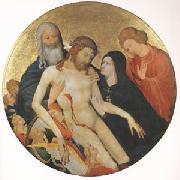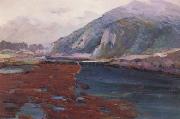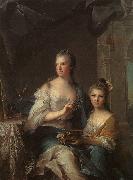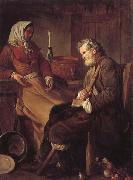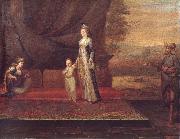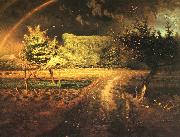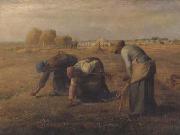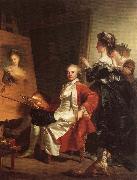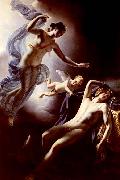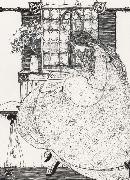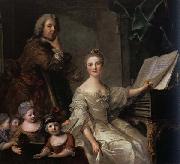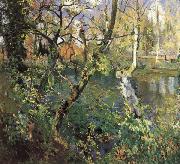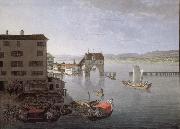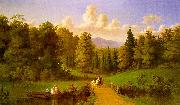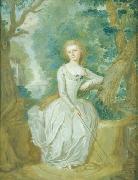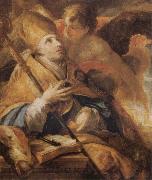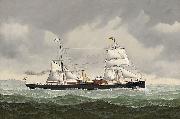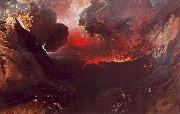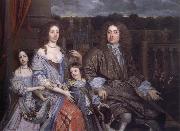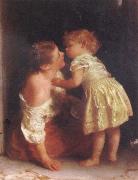|
|
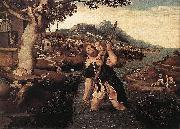 |
Jan Mostaert
|
|
(c. 1475 -1555/1556) was a Dutch painter of portraits and religious subjects, though his most famous creation was the "West Indies Landscape".
Although little is known of him, Mostaert was born and lived in Haarlem for most of his life. He worked as portraitist for Margaret of Austria, Regent of the Netherlands.
Much of his work was destroyed in the great fire of Haarlem in 1576, and some paintings once attributed to him are now attributed to Adriaen Isenbrant.
Mostaert was born in or about 1475 in Haarlem, Netherlands, to a famous noble family. Said to be handsome, eloquent and polite, Mostaert honed his craft under the guidance of Jacob van Haarlem, who may have actually been the anonymous "Master of the Brunswick Diptych". He is also said to be linked to the early Haarlem School of Painting. Mostaert's name first appeared in city records in 1498, the year he married and bought a house in his birthplace. He is also mentioned in Haarlem archives from 1527 to 1554. In 1500 Mostaert was commissioned to paint the shutters for a receptacle housing the relics of Saint Bavo in the Groote Kerk, Haarlem. From this date he began to be listed in the records of the Haarlem Guild of St. Luke, and continued to be frequently listed until 1549. He became deacon of the painters' guild in 1507, and again in 1543 and 1544.
His earliest works are noticeably influenced by Geertgen tot Sint Jans, an earlier Haarlem artist. Some believed that Mostaert was actually apprenticed to tot Sint Jans but it is doubtful that the artist had any apprentices or workshop assistants during his career. From tot Sint Jans, Mostaert adopted a refined style and thoughtful compositions for his works, as well as the stiff, angular look of his figures.
St. ChristopherBetween 1510 and 1516 Mostaert developed a delicate style where his doll-like figures inhabited bright, blue-skied landscapes, as for example in his "Adoration of the Magi" (c. 1510-15). His refined brushwork is precise, with an almost religious attention to detail. Also of note is the landscape, which demonstrates his leanings towards more romantic views with expansive hills. During the 1520s Mostaert was also influenced by Joachim Patinir's take on landscapes. Mostaert's "St. Christopher", a painting with a landscape that features a river receding into an expansive and hilly background, was once even attributed to Patinir.
Mostaert's portrait work of this earlier period includes a piece entitled "Portrait of Abel van den Coulster" (c. 1500-10), in which an elegant, thin-faced man is situated in equally elegant surroundings. Mostaert was known for copying original portraits for some of his courtly commissions but, as is the case with the "Portrait of Abel", he also painted figures from life and added aristocratic touches. He was known for presenting his portrait sitters in three-quarter-length and placing their hands on cushions. |
|
|
|
|
|
|
|
|
|
|
|
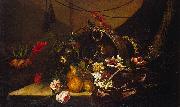 |
Jean-Baptiste Monnoyer
|
|
(12 January 1636 - 20 February 1699) was a Franco-Flemish painter who specialised in flower pieces. He was attached to the Gobelins tapestry workshops and the Beauvais tapestry workshops, too, where he produced cartoons of fruit and flowers for the tapestry-weavers, and at Beauvais was one of three painterswho collaborated to produce cartoons for the suite The Emperor of China.
He was born at Lille, but was in Paris by 1650, where he was documented working on the decors of the Hôtel Lambert. He was taken up by Charles Le Brun for decorative painting at the Château de Marly and at the Grand Dauphin's residence, the Château de Meudon. He was received at the Academie Royale de Peinture et de Sculpture in 1665 with a piece of the genre that he made his specialty, a still life of flowers and fruit combined with objets d'art. His only appearance at the Paris salon was in 1673. |
|
|
|
|
|
|
|
|
|
|
|
|
|
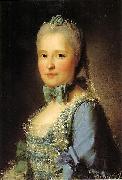 |
Jean-Martial Fredou
|
|
Jean-Martial Fredou (28 January 1710 e 1795) was a French painter known for his portraits.
Born at Fontenay-Saint-Pere, Fredou was attached to the Cabinet du Roi housed in the Hôtel de la Surintendance at Versailles, where he was commissioned to render duplicates of official portraits of the French royal family painted by Jean-Marc Nattier, Maurice Quentin de La Tour, Louis-Michel Van Loo, Alexander Roslin or Joseph Siffred Duplessis.
In his own commissions he often borrowed elements from the original works of these painters, for he was a deft portraitist himself. Between 1760 and 1762 the dauphine Marie-Josephe de Saxe, daughter-in-law of Louis XV commissioned informal portraits of herself and her children, for her own use. These portraits, whether in oil or drawn aux trois crayons, touched with pastels, have freshness and life.
A modest commission came from the Dauphin and Dauphine in 1757: in 1748 they had earth brought in to the little courtyard of their private apartments at the château de Versailles, closed in with trelliswork, to make a little garden; and Fredou was commissiomed to paint two perspective panels to enlarge the little space.[1]
Fredou was never made a member of the Academie Royale de Peinture et de Sculpture, but he was made First Painter to the comte de Provence in 1776 upon the death of François-Hubert Drouais.
|
|
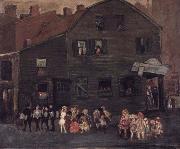 |
Jerome Myers
|
|
(March 20, 1867 - June 19, 1940) was a U.S. artist and writer. Born in Petersburg, Virginia and raised in Philadelphia, Trenton and Baltimore, he spent his adult life in New York City. Jerome worked briefly as an actor and scene painter, then studied art at Cooper Union and the Art Students League where his main teacher was George de Forest Brush. In 1896 and 1914, he was in Paris, but his main classroom was the streets of New York's lower East Side. His strong interest and feelings for the new immigrants and their life resulted in hundreds of drawings, as well as paintings and etchings capturing the whole panorama of their lives as found outside of the crowded tenements which were their first homes in America. |
|
|
|
|
|
|
|
|
|
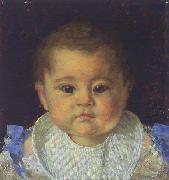 |
Joanna Mary Boyce
|
|
Joanna Mary Boyce, also known as Mrs. H. T. Wells, her married name, (7 December 1831 - 15 July 1861) was an English painter of portraits, genre pictures, and occasionally landscapes. She was the sister of pre-Raphaelite watercolorist George Price Boyce, and was herself associated with the Brotherhood.
|
|
|
|
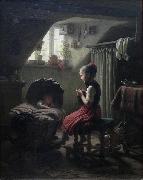 |
Johann Georg Meyer
|
|
Johann Georg Meyer (28 October 1813 Bremen, Germany - 4 December 1886 Berlin), commonly known as Meyer von Bremen, was a German painter who specialized in Biblical, peasant, and family scenes.
In his 2lst year, he went to Desseldorf and began his studies at the Academy of Art there, which was led by Friedrich Wilhelm Schadow, the son of sculptor Johann Gottfried Schadow. In 1841, Meyer opened a studio of his own, but moved to Berlin as his fame increased (1853). While scenes from the Bible were first the subjects of his brush, he later turned his attention to incidents from popular life, especially among the Hessian peasantry, and finally to the portrayal of family life in its pathetic aspect. Such pictures as eThe Jubilee of a Hessian Pastore (1843), hristmas Eve,e eBlindman's Buff,e eThe Soldier's Return,e eThe Inundatione (1846), eThe Repentant Daughtere (1852, in the gallery at Bremen), are full of intense sympathy with the esimple annals of the poor.e After taking up his residence at Berlin, he chose especially scenes from child life, which he rendered with spirited humor. Among his pictures of this kind are eThe Fairy Tale,ehildren Playing Blindman's Buff,e eGrandfather and Grandchild,e and others. A third group of his pictures includes those of young women, as single figures or in groups, such as eThe Tryste and eThe Love Letter.e An example of his work, eThe Lettere (1873), is in the Metropolitan Museum of Art in New York City. |
|
|
|
|
|
|
|
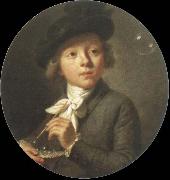 |
johann melchior wyrsch
|
|
johann melchior wyrsch (1732-98) was born in buochs, switzerland. in 1753 he went to rome to study with gaetano lapis and then at the academie francaise. |
|
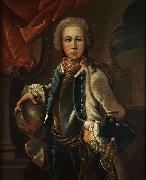 |
Johann Michael Franz
|
|
Seine Eltern waren der Zimmermeister Jakob Franz , und Anna geb. Lueger. Seine Ausbildung genoss er im Umkreis des Augsburger Reichsstädtischen Kunstakademiedirektors Johann Georg Bergmuller (Bergmiller) (1688-1762); nach eigenen Angaben schloss er sie 1733 ab. |
|
|
|
 |
Johann Michael Sattler
|
|
(28 September 1786, Herzogenburg, Lower Austria - 28 September 1847, Mattsee, Salzburg) was an Austrian portrait and landscape painter, best known for his large-scale panoramas.
Sattler attended the Vienna Academy beginning in 1804 under the tutelage of Hubert Maurer. In 1819 Sattler moved to Salzburg, where in 1824 he began to paint a 360-degree panorama of the city as seen from the top of Salzburg's castle. The massive work covered 125 square metres and was first exhibited in 1829. Salzburg made him an honorary resident. Stattler toured across Europe with the painting for ten years, writing about his return in 1838, "with 30 tons and crossing approximately 30,000 kilometres of land and water, a feat no one had ever done before me and one which would be difficult to repeat in the future." Satler's son, the artist Hubert Sattler, donated the work to the city in 1870. The painting is now on display at the Salzburg Museum in a specially designed area called the Panorama Museum. |
|
|
|
 |
Johannes Martini
|
|
(9 June 1866 C 7 February 1935) was a German oil painter and graphic artist.
Martini was born in Chemnitz, Saxony. He was a student of Franz Skarbina at the Akademie der Kenste of Berlin, and he spent two years at the Acad??mie Julian in Paris. Martini exhibited his work at the Great Art Exhibition in Berlin and the Paris Salon. He participated in the jubilee exhibit for the 90th birthday of Luitpold of Bavaria, as well as the Annual Exhibition in Berlin's Glass Palace. |
|
|
|
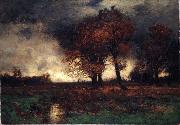 |
John Francis Murphy
|
|
(December 11, 1853 - January 30, 1921), American landscape painter.
He was born at Oswego, New York and first exhibited at the National Academy of Design in 1876, and was made an associate in 1885 and a full academician two years later. He became a member of the Society of American Artists (1901) and of the American Watercolor Society. At first influenced by Wyant and Inness, after 1900 he attacked the modern problems of light and air, thus combining the old and new theories of landscape painting. His chief characteristics are extreme refinement and charm, poetic sentiment, and beauty of surface. His composition is simple and his rendering of soil unique. A past master of values, he preferred the quiet and subdued aspects of nature. He received numerous awards, including a gold medal at Charleston (1902) and the Inness medal in 1910. |
|
 |
John Hamilton Mortimer
|
|
ARA (1740-1779) was a British Neoclassical figure and landscape painter and printmaker, known for romantic paintings set in Italy, works depicting conversations, and works drawn in the 1770s portraying war scenes, similar to those of Salvator Rosa.
Mortimer became President of the Society of Artists in 1774, five years before his death, at age 39.
John Hamilton Mortimer was born on 17 September 1740 at Eastbourne. Not much is known about his family, other than that his father was a customs officer, a dealer in flour and owner of several mills. By 1757, while he was still young, he was studying in London at the Duke of Richmond's Academy. During this time he became a friend of Joseph Wright, a fellow student at the Academy - a friendship which would endure throughout Mortimer's life. Mortimer is also known to have had some professional relationship with the artist Samuel Ireland, who was involved with etching Mortimer's work. At the St Martin's Lane Academy his fellow students included Thomas Jones and William Pars. In 1759 Mortimer won a first prize for a study after Michelangelo's Bacchus and a second prize for a life drawing.
He began to display his works on a regular basis from the early 1760s onwards. He became an active member of the Society of Artists and President of the Society in 1774. |
|
|
|
|
|
 |
John MacWhirter
|
|
(27 March 1839 Slateford, Water of Leith - 28 January 1911 London) was a Scottish landscape painter.
John was the third of four children. He attended a school in Colinton, and after his father's death was apprenticed to Oliver & Boyd, booksellers in Edinburgh. He stayed there for only a few months and then in 1851 enrolled at the Trustees Academy under Robert Scott Lauder and John Ballantyne (1815-97). He spent long periods sketching and studying nature outdoors. His first painting to be exhibited at the Royal Scottish Academy at age 14, was 'Old Cottage at Braid'. In 1880, he was made an Honorary Member of the Royal Scottish Academy. Exploring and painting abroad he visited Italy, Sicily, Switzerland, Austria, Turkey, Norway and the U.S.A. - the Alps being a great inspiration. He moved to London in 1867 and on 4 May 1893 was elected a Royal Academician.
MacWhirter specialised in romantic landscapes with a great fondness for trees, spending much time in the hilly countryside of Perthshire. Initially, under the influence of John Everett Millais, he experimented with the detailed images of the Pre-Raphaelites, but later adopted a more sweeping style. With John Pettie he illustrated The Postman's Bag (Strahan, 1862), and Wordsworth's Poetry for the Young (Strahan, 1863). |
|
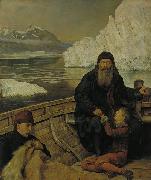 |
John Maler Collier
|
|
(27 January 1850 - 11 April 1934), called 'Jack' by his family and friends, was a leading English artist, and an author. He painted in the Pre-Raphaelite style, and was one of the most prominent portrait painters of his generation. Both his marriages were to daughters of Thomas Henry Huxley. He studied painting at the Munich Academy where he enrolled on 14 April 1875 (Register: 3145) at the age of 25.
Collier was from a talented and successful family. His grandfather, John Collier, was a Quaker merchant who became a Member of Parliament. His father (who was a Member of Parliament, Attorney General and, for many years, a full-time judge of the Privy Council) was created the first Lord Monkswell. He was also a member of the Royal Society of British Artists. John Collier's elder brother, the second Lord Monkswell, was Under-Secretary of State for War and Chairman of the London County Council.
Collier's first wife, Marian Huxley, 1883In due course, Collier became an integral part of the family of Thomas Henry Huxley PC, sometime President of the Royal Society. Collier married two of Huxley's daughters and was "on terms of intimate friendship" with his son, the writer Leonard Huxley. Collier's first wife, in 1879, was Marian (Mady) Huxley. She was a painter who studied, like her husband, at the Slade and exhibited at the Royal Academy and elsewhere. After the birth of their only child, a daughter, she suffered severe post-natal depression and was taken to Paris for treatment where, however, she contracted pneumonia and died in 1887.
In 1889 Collier married Mady's younger sister Ethel Huxley. Until the Deceased Wife's Sister's Marriage Act 1907 such a marriage was not possible in England, so the ceremony took place in Norway. Collier's daughter by his first marriage, Joyce, was a portrait miniaturist, and a member of the Royal Society of Miniature Painters. By his second wife he had a daughter and a son, Sir Laurence Collier KCMG, who was the British Ambassador to Norway 1941-51.
|
|
|
|
 |
john masefield
|
|
(born June 1, 1878, Ledbury, Herefordshire, Eng. ?? died May 12, 1967, near Abingdon, Berkshire) English poet. He went to sea in his youth, then lived precariously for several years in the U.S. before settling in London. He is best known for his poems of the sea, Salt-Water Ballads (1902, including "Sea Fever" and "Cargoes"), and for his long narrative poems, such as The Everlasting Mercy (1911), containing phrases of colloquial coarseness that were unknown in earlier 20th-century English verse. After he became poet laureate in 1930, his poetry became more austere. He also wrote adventure novels, sketches, and works for children.
|
|
|
|
 |
John Mather
|
|
Australian painter, etcher and teacher.
1848-1916
|
|
|
|
|
|
 |
John Mix Stanley
|
|
A famous painter of Indians and Indian scen .
American , 1814-1872 |
|
|
|
|
|
|
|
 |
jonathan miller
|
|
(born July 21, 1934, London, Eng.) British director, writer, and actor. After earning a medical degree at Cambridge University, he made his professional stage debut at the Edinburgh Festival in the hit satirical revue Beyond the Fringe (1960). |
|
|
|
|









